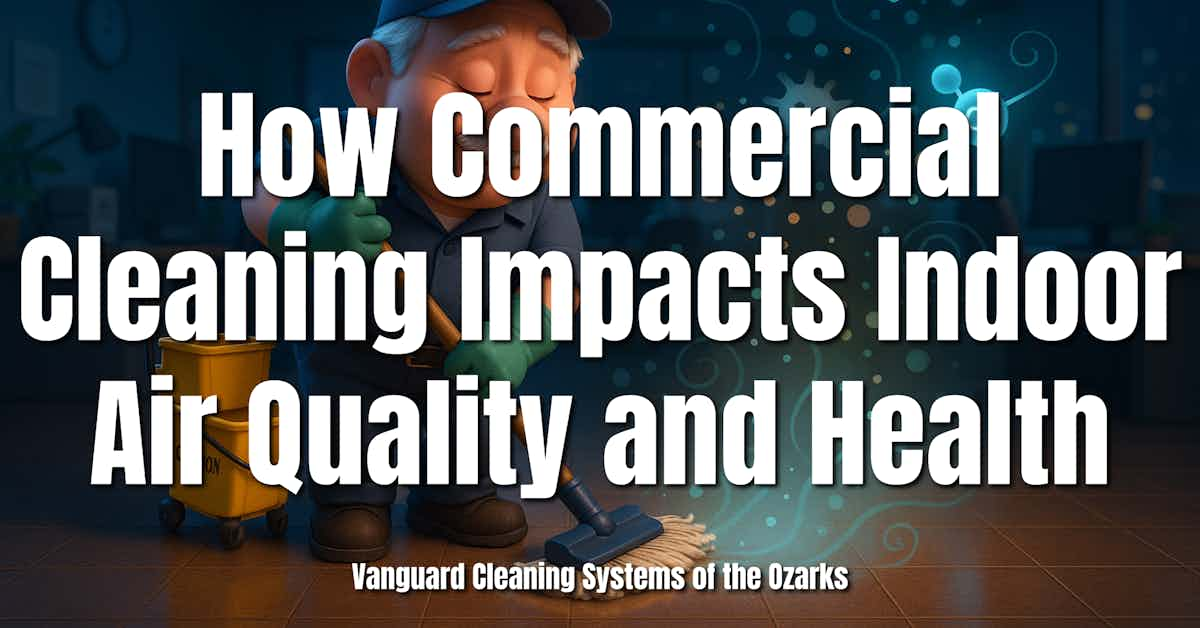Discover how commercial cleaning impacts indoor air quality and health, and learn practical ways to reduce hidden risks.

The Hidden Costs of Clean: How Commercial Cleaning Affects Indoor Air Quality and Health
In today's health-conscious world, commercial cleaning is more essential than ever. Offices, schools, hospitals, and retail spaces all rely on frequent cleaning to ensure hygiene and reduce the spread of illness. But while these practices offer clear benefits, they can also bring unintended consequences—specifically, to the air we breathe indoors.
What many businesses and facility managers don’t realize is that certain cleaning products and procedures can degrade indoor air quality (IAQ). The result? A buildup of chemical pollutants that may irritate the respiratory system, trigger allergies, or contribute to long-term health concerns for building occupants and cleaning staff alike.
This article explores how commercial cleaning impacts indoor air quality and what that means for human health. You’ll learn which cleaning practices are most concerning, what pollutants are released into the air, and how to reduce risks while maintaining a clean and safe environment.
What’s in the Air? Pollutants Released by Commercial Cleaning
Commercial cleaning products are designed to disinfect and remove dirt, but many also release a complex mix of chemicals into the air. These substances don’t just disappear after cleaning—they linger, mix, and sometimes transform into more harmful compounds.
Volatile Organic Compounds (VOCs)
Many cleaning agents contain VOCs like limonene, ethanol, and glycol ethers. These compounds evaporate easily at room temperature, contributing to that “clean” smell—but they also affect indoor air quality. When VOCs react with ozone (often present even indoors), they can form secondary pollutants like formaldehyde and ultrafine particles.
Particulate Matter (PM)
Cleaning activities stir up dust and can generate new particles, especially when products react chemically in the air. These fine and ultrafine particles can bypass the body’s natural defenses and reach deep into the lungs, increasing the risk of respiratory problems.
Reactive Chemical Byproducts
Certain cleaning agents—especially those with fragrances or disinfectants—can react with common indoor air components to create irritants such as ozone-derived aldehydes or nitrated organics. These byproducts are often more harmful than the original ingredients.
Endocrine Disruptors and Carcinogens
Some commercial cleaning products contain synthetic fragrances, phthalates, or chlorinated compounds, which have been linked to hormonal disruption and potential cancer risk. These are especially concerning in environments with prolonged or repeated exposure.
Understanding what cleaning releases into the air is the first step toward healthier indoor environments. The next step is assessing how these pollutants affect the people who breathe them in every day.
Breathing the Consequences: Health Risks of Cleaning-Related Air Pollution
While cleanliness supports hygiene, the air pollutants generated by commercial cleaning can pose serious health risks—especially for those with frequent or prolonged exposure. These risks affect not only professional cleaning staff but also employees, students, and customers who occupy recently cleaned spaces.
Respiratory Irritation and Disease
Exposure to airborne irritants like VOCs and fine particulate matter can lead to coughing, wheezing, throat irritation, and shortness of breath. Over time, repeated exposure is associated with chronic respiratory conditions such as asthma and bronchitis, particularly among vulnerable groups like children and individuals with pre-existing conditions.
Increased Asthma Risk
Numerous studies have linked the use of chemical cleaning products with both the onset and worsening of asthma. Professional cleaners are especially at risk, but even passive exposure—such as working in a recently cleaned office—can trigger asthma-like symptoms in sensitive individuals.
Allergic Reactions and Sensitivities
Synthetic fragrances and other additives in cleaning agents can act as allergens, leading to headaches, skin irritation, eye discomfort, and sinus issues. These effects are often underreported but are common complaints in tightly sealed or poorly ventilated commercial buildings.
Long-Term Health Effects
Some ingredients used in disinfectants and deodorizers—such as formaldehyde, phthalates, and certain phenols—have been linked to more serious health concerns. These include hormone disruption, reproductive issues, and elevated cancer risk with chronic exposure.
The cumulative impact of these health effects highlights a clear need: to clean smarter, not just harder. In the next section, we’ll explore practical steps businesses can take to minimize harm while maintaining effective hygiene.
Looking for Reliable Commercial Cleaning?
Discover expert cleaning solutions tailored for your Tulsa business.
Cleaning Smarter: How to Reduce Indoor Air Risks Without Sacrificing Hygiene
Improving indoor air quality doesn’t mean compromising on cleanliness. With intentional choices and smarter strategies, commercial spaces can stay both clean and healthy.
Choose Low-Emission or Green-Certified Products
Switching to cleaning agents labeled as low-VOC, fragrance-free, or certified by reputable eco-labels (like Green Seal or EcoLogo) can significantly reduce harmful emissions. These products are formulated to clean effectively without releasing hazardous chemicals into the air.
Improve Ventilation During and After Cleaning
Proper ventilation—especially during cleaning—helps disperse airborne pollutants before they can accumulate. Open windows when possible, use mechanical ventilation systems effectively, and consider upgrading HVAC filters to better capture fine particles and VOCs.
Avoid Overuse of Disinfectants
While disinfection is essential in certain settings, daily use of strong chemical disinfectants in low-risk areas can be excessive. Follow label instructions and only disinfect when necessary, especially in spaces without known exposure to infectious diseases.
Schedule Cleaning Strategically
Cleaning when a building is unoccupied—such as evenings or weekends—can reduce direct exposure. Allow adequate time for ventilation after cleaning before spaces are reoccupied.
Train Staff in Safe Cleaning Practices
Provide clear guidance to cleaning staff on proper product use, dilution, storage, and personal protective equipment (PPE). Education helps reduce chemical misuse and accidental overexposure, especially for those handling multiple products daily.
Explore Air Purification Solutions
Supplemental air cleaning devices, such as HEPA filters and activated carbon purifiers, can help remove residual pollutants from indoor air. These systems are particularly useful in high-occupancy spaces or areas with limited ventilation.
By adopting these strategies, facility managers and business owners can safeguard indoor air quality—supporting both health and productivity. Up next, we’ll tie everything together with key takeaways and action points.
Frequently Asked Questions (FAQ)
How does commercial cleaning affect indoor air quality?
Commercial cleaning can release volatile organic compounds (VOCs), particulate matter, and other pollutants into the air, which may degrade indoor air quality and contribute to respiratory and other health issues.
What are VOCs, and why are they harmful?
VOCs (volatile organic compounds) are chemicals that easily become vapors or gases. Many cleaning products contain VOCs that can irritate the eyes, nose, and throat, trigger asthma, and react with other indoor pollutants to form harmful byproducts like formaldehyde.
Can cleaning products cause health problems?
Yes. Frequent exposure to chemicals in cleaning products has been linked to asthma, allergies, skin irritation, and even long-term risks like endocrine disruption or cancer, especially in poorly ventilated spaces.
How can I reduce the air quality impact of commercial cleaning?
Use low-VOC or fragrance-free cleaning products, improve ventilation during and after cleaning, limit the use of harsh disinfectants, and ensure cleaning staff are trained in safe practices.
Are green or eco-labeled cleaning products safer?
Generally, yes. Products certified by organizations like Green Seal or EcoLogo are formulated to reduce harmful emissions and environmental impact, making them better for both health and air quality.
When is the best time to clean a commercial space?
Cleaning during off-hours (like evenings or weekends) with adequate ventilation time before re-occupancy can minimize exposure to airborne pollutants.
Do air purifiers help with cleaning-related pollutants?
Yes. Air purifiers with HEPA and activated carbon filters can help remove particles and VOCs generated by cleaning activities, improving overall indoor air quality.
References
- Rosales, C., Jiang, J., Lahib, A., Bottorff, B., Reidy, E., Kumar, V., Tasoglou, A., Huber, H., Dusanter, S., Tomas, A., Boor, B., & Stevens, P. (2022). Chemistry and human exposure implications of secondary organic aerosol production from indoor terpene ozonolysis. Science Advances, 8. https://doi.org/10.1126/sciadv.abj9156
- Salonen, H., Salthammer, T., Castagnoli, E., Täubel, M., & Morawska, L. (2024). Cleaning products: Their chemistry, effects on indoor air quality, and implications for human health.. Environment international, 190, 108836 . https://doi.org/10.1016/j.envint.2024.108836
- Wei, W., Boumier, J., Wyart, G., Ramalho, O., & Mandin, C. (2016). Cleaning practices and cleaning products in nurseries and schools: to what extent can they impact indoor air quality?. Indoor air, 26 4, 517-25 . https://doi.org/10.1111/ina.12236
- Wei, W., Boumier, J., Wyart, G., Ramalho, O., & Mandin, C. (2016). Cleaning practices and cleaning products in nurseries and schools: to what extent can they impact indoor air quality?. Indoor air, 26 4, 517-25 . https://doi.org/10.1111/ina.12236
- Carslaw, N., & Shaw, D. (2022). Modification of cleaning product formulations could improve indoor air quality. Indoor Air, 32. https://doi.org/10.1111/ina.13021
- Fisk, W., Destaillats, H., & Sidheswaran, M. (2011). Saving energy and improving IAQ through application of advanced air cleaning technologies. , 48 https://www.osti.gov/servlets/purl/1050686
Key Takeaways: Balancing Cleanliness with Indoor Air Quality
Commercial cleaning is vital for maintaining safe, hygienic environments—but without thoughtful practices, it can unintentionally compromise indoor air quality and human health. Here’s what to remember:
1. Cleaning products emit more than just scent
Many contain VOCs, synthetic fragrances, and reactive chemicals that can linger in the air and form harmful byproducts.
2. Poor air quality affects everyone
From cleaning staff to office workers and students, exposure to indoor air pollutants has been linked to asthma, allergies, respiratory irritation, and even long-term health risks.
3. Simple changes can reduce harm
Selecting low-emission products, increasing ventilation, and educating cleaning staff can significantly reduce pollutant levels and health impacts.
4. Smarter scheduling matters
Cleaning during off-hours and allowing time for fresh air circulation can minimize exposure for building occupants.
5. Clean doesn't have to mean chemically intensive
Effective cleaning can be achieved with safer, more sustainable products and practices—improving both hygiene and indoor air quality.
By rethinking how cleaning is approached in commercial spaces, businesses can protect the health of their people while maintaining the standards of cleanliness that today’s environments demand.
Vanguard Cleaning Systems of the Ozarks' franchise-owned custodial service provider business cleans more than 8M sq. ft. weekly, maintaining an industry-topping 95+% of its customer base, year-over-year, and boasting more than 60 5-star Google reviews.
Need more capability from your vendor partners? --Let's talk.
In Oklahoma, dial 918-960-4450
In Arkansas, dial 479-717-2410
In Missouri, dial 417-812-9777

